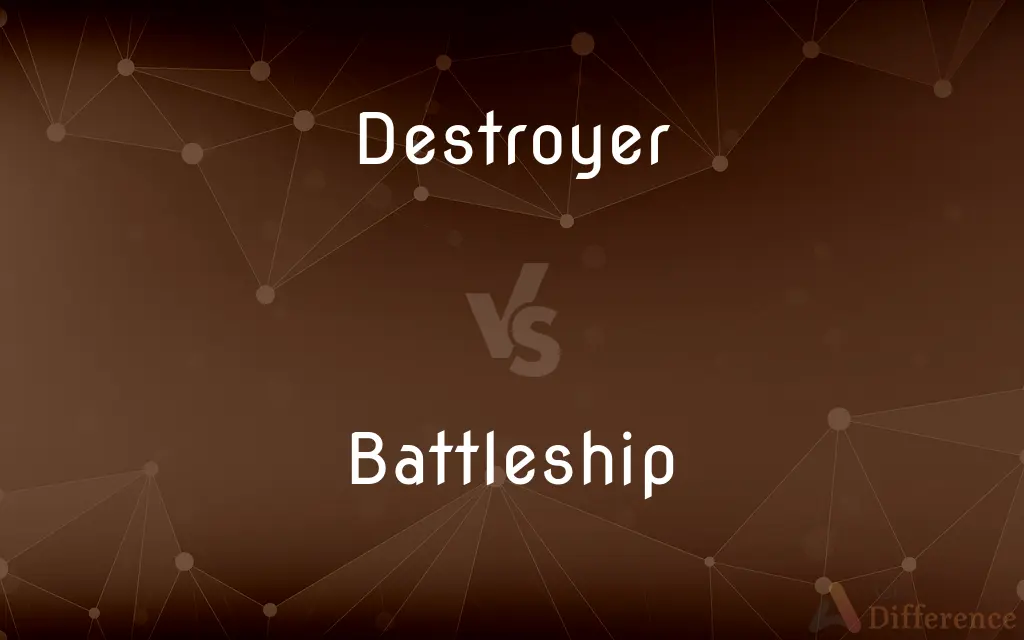Destroyer vs. Battleship — What's the Difference?
By Tayyaba Rehman — Updated on August 28, 2023
A destroyer is a fast, maneuverable, long-endurance naval ship designed primarily for anti-submarine warfare and escort duties. In contrast, a battleship is a heavily armored ship with large-caliber guns, built for naval warfare domination.

Difference Between Destroyer and Battleship
Table of Contents
ADVERTISEMENT
Key Differences
Destroyers and battleships, both integral to naval fleets, serve distinct roles in maritime combat. A destroyer, agile and swift, is primarily tailored for protective functions, such as guarding larger vessels or convoys from submarine threats. Battleships, on the other hand, stand as the behemoths of the sea, boasting immense firepower and armor designed for frontline naval warfare.
The inception of the destroyer can be traced back to the need for a vessel that could defend against torpedo boats. With time, the role of the destroyer evolved, accommodating anti-submarine warfare, anti-aircraft warfare, and more. Battleships, with their historical gravitas, have been the embodiment of naval strength, often serving as flagships due to their intimidating presence and firepower.
One can observe the differences between a destroyer and battleship even in their physicality. Destroyers are comparatively smaller, optimizing for speed and agility, while battleships are large, emphasizing armor and weapon capacity. In modern naval strategy, the relevance of battleships has waned with advancements in missile technology, but destroyers continue to play a vital role, adapting to contemporary warfare needs.
While both destroyers and battleships are designed for combat, their operational strategies differ. Destroyers operate in numbers, utilizing their agility to execute coordinated strikes or defenses. Battleships, given their formidable nature, can operate more independently, relying on their heavy armament to dominate the seas. The complementary strengths of both vessels underscore the strategic depth of naval warfare.
Comparison Chart
Primary Role
Anti-submarine warfare, escort duties.
Frontline naval warfare, sea domination.
ADVERTISEMENT
Size & Speed
Smaller, designed for speed and agility.
Larger, heavily armored, slower in comparison.
Firepower
Torpedoes, anti-aircraft guns, missiles.
Large-caliber guns, immense firepower.
Historical Role
Defense against torpedo boats, anti-submarine operations.
Embodiment of naval strength, often served as flagships.
Modern Relevance
Continues to play a crucial role in naval strategy.
Waned due to missile technology advancements.
Compare with Definitions
Destroyer
A fast, agile naval ship primarily for escorting and guarding.
The destroyer quickly moved to intercept the incoming threat.
Battleship
A battleship is a large armored warship with a main battery consisting of large caliber guns, which dominated naval warfare in the late 19th and early 20th centuries. The term battleship came into use in the late 1880s to describe a type of ironclad warship, now referred to by historians as pre-dreadnought battleships.
Destroyer
A vessel equipped for anti-submarine operations.
The fleet relied on the destroyer to keep submarines at bay.
Battleship
A heavily armored naval vessel with large-caliber guns.
The battleship's cannons roared, showcasing its immense firepower.
Destroyer
A warship smaller than a cruiser.
The destroyer flanked the larger vessels, providing a protective shield.
Battleship
A ship built for dominating sea warfare.
The opposing fleet retreated at the sight of the formidable battleship.
Destroyer
A ship designed for speed and maneuverability.
The agile destroyer could swiftly navigate through challenging waters.
Battleship
A naval ship historically serving as a flagship due to its strength.
The admiral's flag flew high on the battleship, leading the fleet.
Destroyer
A naval ship outfitted with torpedoes and anti-aircraft weaponry.
The destroyer was armed and ready for any aerial or underwater threat.
Battleship
A vessel designed for prolonged combat engagements.
The battleship, with its robust armor, stood resilient against the onslaught.
Destroyer
In naval terminology, a destroyer is a fast, maneuverable, long-endurance warship intended to escort larger vessels in a fleet, convoy or battle group and defend them against powerful short range attackers. They were originally developed in the late 19th century by Fernando Villaamil for the Spanish Navy as a defense against torpedo boats, and by the time of the Russo-Japanese War in 1904, these "torpedo boat destroyers" (TBDs) were "large, swift, and powerfully armed torpedo boats designed to destroy other torpedo boats".
Battleship
Large and heavily armoured warship
Destroyer
A small, fast warship, especially one equipped for a defensive role against submarines and aircraft.
Battleship
A non-functional rocket stage, used for configuration and integration tests.
Destroyer
A person or thing that destroys something
CFCs are the chief destroyers of the ozone layer
Battleship
An armor-plated warship built of steel and heavily armed, generally having over ten thousand tons displacement, and intended to be fit to combat the heaviest enemy ships in line of battle; the most heavily armed and armored class of warship at any given time.
Destroyer
One that destroys
A destroyer of our environment.
Battleship
The largest and most heavily armed type of naval ship.
The battleship overshadowed other vessels with its sheer size and weaponry.
Destroyer
A small, fast, highly maneuverable warship typically armed with an assortment of weapons such as guns, torpedoes, depth charges, and guided missiles.
Battleship
Any of a class of very large warships, heavily armored and armed with numerous large-caliber guns. Also called battlewagon.
Destroyer
That which destroys something.
Battleship
A ship of the line.
Destroyer
A small, fast warship with light gun armament, smaller than a cruiser, but bigger than a frigate.
Battleship
A guessing game played on grid paper; see Battleship (game).
Destroyer
(military) A larger warship with guided missile armament, usually intended for air defence or anti-ship roles. Often, but not always, larger than a frigate and smaller than a cruiser.
Battleship
A large capital warship displacing thousands to tens of thousands of tons, heavily armoured and armed with large-caliber guns; now obsolescent and replaced by smaller vessels with guided missiles.
Destroyer
One who destroys, ruins, kills, or desolates.
Battleship
A heavy warship of a type built chiefly in the late 19th and early 20th centuries, with extensive armour protection and large-calibre guns.
Destroyer
A small fast warship used primarily as an escort to larger vessels and typically armed with a combination of 5-inch guns, torpedos, depth charges, and missiles; formerly identical to the Torpedo-boat destroyer.
Destroyer
A person who destroys or ruins or lays waste to;
A destroyer of the environment
Jealousy was his undoer
Uprooters of gravestones
Destroyer
A small fast lightly armored but heavily armed warship
Common Curiosities
Are destroyers larger than battleships?
No, battleships are typically larger and more heavily armored than destroyers.
Why are battleships not as common today?
With advancements in missile technology and naval strategy, battleships' dominance has reduced, making them less common in modern fleets.
Can destroyers take on larger vessels in combat?
While destroyers are equipped for combat, their primary role is often escort and defense rather than direct engagement with larger warships.
What makes a battleship unique from other naval ships?
Battleships are known for their heavy armor, large-caliber guns, and their role as flagships in historical naval warfare.
How have destroyers evolved over time?
Destroyers have adapted to modern warfare needs, with enhanced anti-submarine, anti-aircraft, and missile capabilities.
Share Your Discovery

Previous Comparison
Descend vs. Ascend
Next Comparison
Billfold vs. WalletAuthor Spotlight
Written by
Tayyaba RehmanTayyaba Rehman is a distinguished writer, currently serving as a primary contributor to askdifference.com. As a researcher in semantics and etymology, Tayyaba's passion for the complexity of languages and their distinctions has found a perfect home on the platform. Tayyaba delves into the intricacies of language, distinguishing between commonly confused words and phrases, thereby providing clarity for readers worldwide.













































